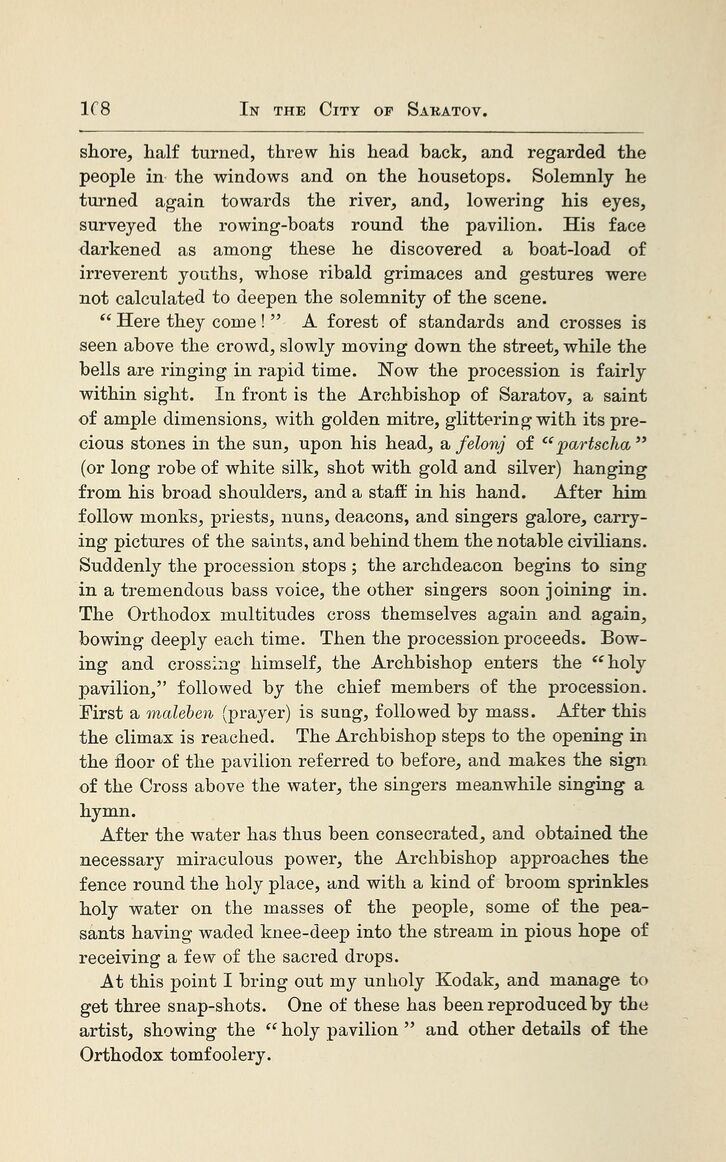
Full resolution (JPEG) - On this page / på denna sida - XI. In the City of Saratov

<< prev. page << föreg. sida << >> nästa sida >> next page >>
Below is the raw OCR text
from the above scanned image.
Do you see an error? Proofread the page now!
Här nedan syns maskintolkade texten från faksimilbilden ovan.
Ser du något fel? Korrekturläs sidan nu!
This page has been proofread at least once.
(diff)
(history)
Denna sida har korrekturlästs minst en gång.
(skillnad)
(historik)
shore, half turned, threw his head back, and regarded the
people in the windows and on the housetops. Solemnly he
turned again towards the river, and, lowering his eyes,
surveyed the rowing-boats round the pavilion. His face
darkened as among these he discovered a boat-load of
irreverent youths, whose ribald grimaces and gestures were
not calculated to deepen the solemnity of the scene.
“Here they come!” A forest of standards and crosses is
seen above the crowd, slowly moving down the street, while the
bells are ringing in rapid time. Now the procession is fairly
within sight. In front is the Archbishop of Saratov, a saint
of ample dimensions, with golden mitre, glittering with its
precious stones in the sun, upon his head, a felonj of “partscha”
(or long robe of white silk, shot with gold and silver) hanging
from his broad shoulders, and a staff in his hand. After him
follow monks, priests, nuns, deacons, and singers galore,
carrying pictures of the saints, and behind them the notable civilians.
Suddenly the procession stops; the archdeacon begins to sing
in a tremendous bass voice, the other singers soon joining in.
The Orthodox multitudes cross themselves again and again,
bowing deeply each time. Then the procession proceeds.
Bowing and crossing himself, the Archbishop enters the “holy
pavilion,” followed by the chief members of the procession.
First a maleben (prayer) is sung, followed by mass. After this
the climax is reached. The Archbishop steps to the opening in
the floor of the pavilion referred to before, and makes the sign
of the Cross above the water, the singers meanwhile singing a
hymn.
After the water has thus been consecrated, and obtained the
necessary miraculous power, the Archbishop approaches the
fence round the holy place, and with a kind of broom sprinkles
holy water on the masses of the people, some of the
peasants having waded knee-deep into the stream in pious hope of
receiving a few of the sacred drops.
At this point I bring out my unholy Kodak, and manage to
get three snap-shots. One of these has been reproduced by the
artist, showing the “holy pavilion” and other details of the
Orthodox tomfoolery.
<< prev. page << föreg. sida << >> nästa sida >> next page >>